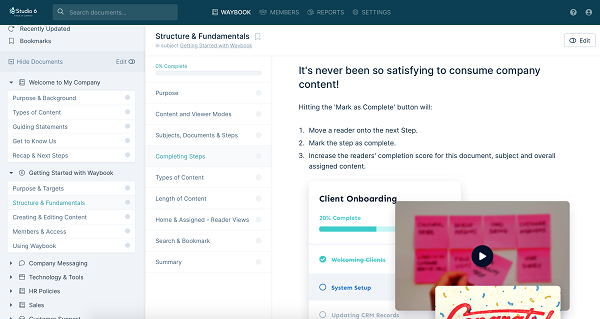Making an Employee Handbook that Truly Engages Your Staff
You could be working with the most talented staff the world has to offer, and still have an organization with high turnover, low engagement, and unmet expectations of your company by employees. A lot of problems can be solved by addressing management issues through training and other means. But, if you learn how to create an effective employee handbook, you can e many of these issues from the very beginning of someone’s employment with your business.
The reasons that employee handbooks work so well is that they help set the right expectations, lower the possibility of frustrations and stress associates with a new job, and are an excellent way to maintain company transparency. They show people that staff is supported throughout their entire experience, and provide a reference tool for new workers to turn to before asking common questions. Here’s how to write your company handbook so that new staff members become valuable long term employees.
Make Sure to Include These Elements in Your Content:
When coming up with a handbook that engages, it helps to think of the book as a navigation manual for your company. You want to include all important aspects of working within the organization and answer the common questions that a newbie may have. Here’s a checklist for creating a comprehensive outline for your employee handbook, as per the guidelines laid out by the SBA.
- Non-Disclosure Agreements (NDAs) & Conflict of Interest Statements
- Anti-Discrimination Policies
- Compensation
- Work Schedules
- Standards of Conduct
- General Employment Information
- Safety & Security
- Computers & Technology
- Media Relations
- Employee Benefits
- Leave Policies
There is no need to stop here. You are free to include mission statements and anything else that showcases your company as well as provides value to employees. Including these elements ensures that workers have access to the necessary information about being a part of your establishment.
Remember: Print is Dead
You already know that destroying rainforests is a sure road to global disaster. Paperless billing is increasing in popularity and ebooks are replacing physical libraries. Remembering this is especially important for software development firms and technology companies, since your employees are more tech savvy than average. This means that they almost definitely spend their lives online. For optimal engagement, your employee handbook should also be online.
Do this using Waybook which brings all your handbooks, onboarding and documentation in one place. You can sort your documents by subjects that match your company departments – and Waybook makes it interactive for employees to read documents with support for PDFs, videos and GIFs. Getting your team on board is easy: all customers get free 1-1 expert support and templates for SOPs, employee handbooks and department guides. You can start with Waybook for free today.
Blissbook is another tool available to help you create a digital employee handbook. Features include esignature options, advanced reporting, custom branding, variable content, simple content management, 24/7 access, easy user management, multiple handbooks, groups, desktop, tablet, phone, or printed options, a safe, secure, reliable platform, and a free trial. This company will create the handbook for you, to your specifications, or allow you to design your own.
How Can You Make Employees Feel Like Part of the Team?
One of the best ways to make employees feel like a part of your company is to just tell them what they’ve gotten into. Write your employee handbook as if it is an enticing welcome package. Aside from the basic elements of your employee handbook, or right along with them, say thank you to each person who decided to become a part of your team. Include links to valuable information including the company blog, online training courses, ebooks that you have published, articles about the PR and outreach you’ve done and the projects and charities you’ve contributed to, and anything else that creates the perception of something bigger than just the offices they’ll be working in. You want them to know that the team they have joined is worth sticking with.
A great example of a link to valuable information is included in Valve’s Handbook for New Employees. They send new employees to an article about cabals written by Ken Bidwell to help tell the story of their company vision. This was a brilliant way to reach outside the company even, to touch on subjects that may spark inspiration to value their contemporary business structure. Ideas like this will help you keep your staff on board with current and future policies.
Use This Opportunity to Gather Helpful Data
The employee handbook isn’t traditionally the place for questions, but for information. This may be counterproductive, however, since it’s the perfect opportunity to find out what motivates new staff members. Including a survey in the materials will give you valuable insight while letting people know that you’re listening. Even if you don’t act on any suggestions right away, your employees will know that you care enough to ask.
In Conclusion
If it’s engagement you seek, here are the elements of an effective employee handbook: Include all the traditional elements for professionalism, create a digital version of the information, engage employees with valuable extras, and include a brief employee survey. Combining these tips, when creating the guide to working for your company, will definitely contribute to employee engagement.
About the author: Eva Creerson is a career counselor at Master Papers writing service. She also loves writing, that’s why in her free time she blogs about career and employment.
Image licensed from dollarphotoclub.com







Leave A Comment